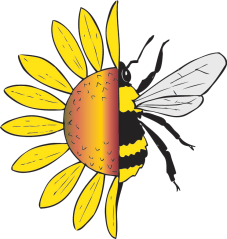Flies (Diptera spp.) are an eclectic group of pollinators with many species that mimic bees. The bee fly or humblefly is a perfect example of a batesian mimic, a harmless fly mimicking a potentially harmful bee as a deterrent to predation. This fuzzy little fly, reminiscent of a bumble bee, has a stout body, very long legs and a very long proboscis that allow it to hover a safe distance from the flower to avoid lurking predators. It produces a loud buzzing sound as it navigates on fast moving wings. It is a quick moving insect but when it finds a flower with some sweet nectar it will hover above it for a moment to drink its fill.
The bee fly visits a variety of spring ephemerals for their nectar but on a recent April day in Stewart State Forest I was perplexed to find a bee fly at a blood root, a flower that produces no nectar. The fly was very persistent in trying to “get blood from a stone” or was it actually collecting pollen? Some flies do seek protein rich pollen that is needed by some adult insects in order to reproduce. I can only surmise why the interest in this flower on this day.
On a darker note, this fly is parasitic too many spring bees in the Andrena family. The fly deposits it eggs in or near a nesting chamber of the bees where it will hatch and eat the developing larvae. It overwinters as a pupae in the underground nest chamber to emerge the following spring as an adult.
Bees are designed for pollination and are certainly natures number one pollinators. Flies are the second most important group of pollinators whose work and value go unnoticed and under-appreciated. Worldwide there are over 120,000 described fly species in 150 families, 71 families have flies that feed at flowers as adults. In some cases, flies are the preferred pollinators of some plants that have gone to extraordinary lengths to attract them. Some flowers called carrion flowers intentionally mimic the smell of rotting flesh to attract flies. Flies seeking a place to lay their eggs are lured to the smell of rotting meat only to discover they have been fooled with a false promise. The fly leaves disappointed most likely covered with the precious cargo of the plants pollen that will be deposited on another flower should the fly again be fooled by the plants trickery. It is interesting to speculate how a plant would evolve to imitate the smell of rotting meat or produce the smell of a certain fungus as a means to trick a fly into pollinating it. This is the power of natural selection, the long trial and error process of evolution. Some common examples in our region of fly or gnat pollination include skunk cabbage, jack-in-the-pulpit, wild ginger, pawpaw and red trillium (aka Stinking Benjamin).
Not all flies are attracted to the smell of decay but to the same sweet smelling flowers as bees. The Syrphidae family are known as flower flies and are represented by over 6,000 species worldwide. These bees at first glance are easily confused with bees and wasp whom they mimic with yellow and black stripes. This protective coloring has fooled many would be predators and ill-informed humans. Flies in this group not only benefit plants as pollinators but 40% of flies in this group have zoophagus larvae that are an excellent biocontrol in eating harmful aphids and other garden pests. This is a very beneficial group of flies to farmers and gardeners.
Flies make excellent pollinators for a variety of reasons including the ability to be active at cooler temperatures than bees. The farther north one travels the greater a flies importance in pollinating. In the High Arctic for example the muscid fly, the family of flies that include the house fly, are the dominant pollinators. At our mid-latitude the fuzzy little bee fly, in the genus Bombylius, found visiting the bloodroot is a reminder that there is much we do not know about flies or the impact they have as the pollinators. More research is needed to study these valuable insects that fly in the shadow of bees.
Resources:
- http://diptera.myspecies.info/diptera/content/flies-–pollinators-two-wings
- https://www.fs.fed.us/wildflowers/pollinators/animals/flies.shtml
Categories: Flies, pollinators, spring ephemerals







